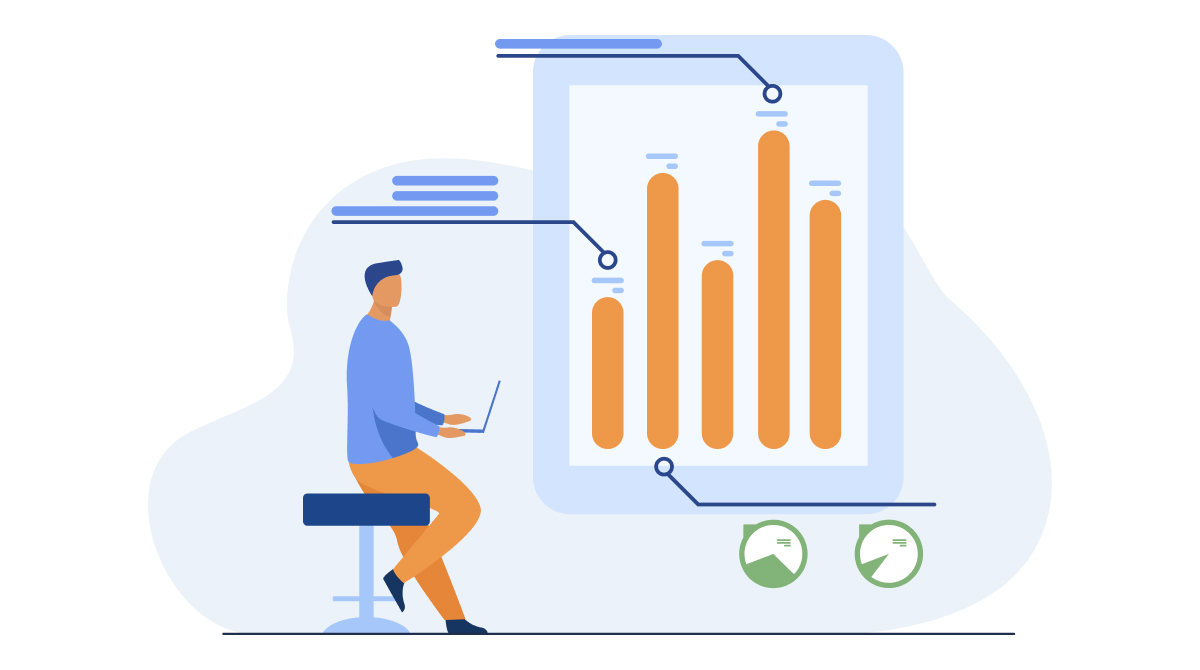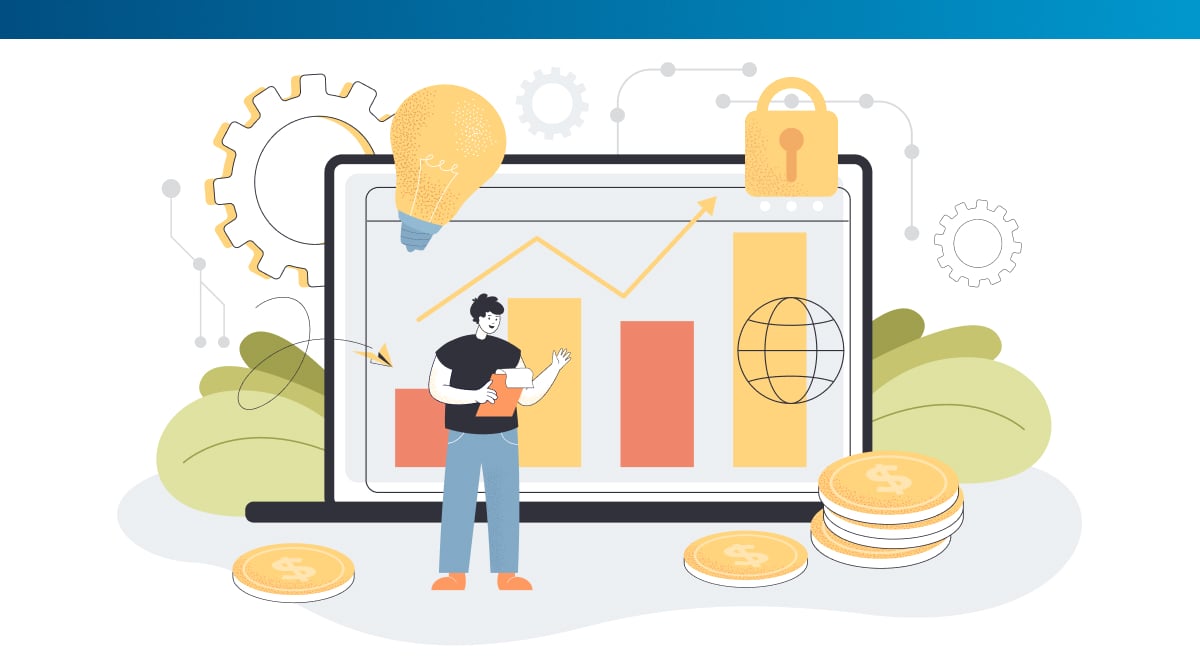The success of your SaaS business can be measured with many different metrics. You’re no stranger to using formulas to figure out how well your business is doing. If you’re not already focusing on net revenue retention and acknowledging its importance, it’s time to change that.
Net revenue retention – or NRR, for short – is a measurement of recurring revenue that comes in from your existing customer base over a period of time. Generally, NRR looks at how much revenue is coming (from your existing customers only – new customers are not part of this calculation) over a month or a year. It’s sometimes called net dollar retention, or NDR.
Not to be confused with gross revenue retention, NRR paints a picture of your whole existing customer experience, from upgrades to downgrades to customer churn rates, to determine how much you could scale your business if you only used your current customers to do so.
NRR is critical because it helps SaaS companies understand whether they can sustain their current revenue growth with their existing customers. Because new customers aren’t included, NRR gives a realistic overview of what to expect if your customer retention efforts are successful.
Understand NRR and its Significance for SaaS Businesses
There’s a reason that NRR is such an important metric for SaaS businesses. Investors want to see a steady revenue growth rate because that indicates good business health. This means focusing on customer success to reduce your churn rate.
You might wonder if monthly recurring revenue (MRR) is a better metric for measuring revenue growth, but there’s a good reason to opt for NRR calculations instead. MRR and ARR (annual recurring revenue) both include revenue from new customers.
With that comes customer acquisition costs, which are a whole different beast but are not included in NRR for a reason.
While those figures are essential, NRR allows you to zero in on any potential problems beneath the surface, like customer experience and pricing. Other metrics have the potential to conceal those issues with numbers inflated by new customers.
Net Revenue Retention vs Gross Revenue Retention
Let’s look at two key metrics: net revenue retention and gross revenue retention (GRR).
| Net Revenue Retention | Gross Revenue Retention |
| More comprehensive than GRR: considers revenue from upgrades | Excludes revenue from upgrades |
| May not reveal issues with retention | Focuses on income retention and lost revenue from current customers |
| Can and should exceed 100% | Cannot exceed 100% |
Both NRR and GRR are important, but NRR is generally considered the superior metric for SaaS businesses because it’s more comprehensive and offers a more in-depth look at the overall state of a company.
That said, if you’re looking for information about lost revenue, gross revenue retention is a great place to start.
How to Calculate Net Revenue Retention
The net revenue retention formula calculates NRR, and it’s easy to use if you know what the components mean.

Here’s the formula:
NRR = (MRR + Expansion MRR) - (Churn MRR + Contractions)
MRR
Before we dive into an example, there are a few things to note about the NRR formula.
- When looking at the MRR, take the figure from the beginning of the month.
- That starting MRR figure is based on the previous month’s recurring revenue from existing customers.
- Expansion revenue comes from existing customers who paid for upgrades in the last month.
- Contractions refer to the lost revenue resulting from downgrades by your existing base.
- Remember that revenue from new customers is not considered in this formula.
Let’s look at an example:
At the beginning of the month, your business has a starting monthly recurring revenue of $20,000. Thanks to upgrades and renewals, by the end of the month, the monthly recurring revenue from the existing customer base is $30,000. But some customers unfortunately opted for cancellations, leaving you with $3,000 in revenue churn.
Based on these figures, your net revenue retention rate is 135%: ($20,000 + $10,000 - $3,000) divided by $20,000.
This would be considered a good NRR, as would anything above 100%.
Net Revenue Retention Benchmarks
SaaS metrics can provide industry benchmarks that help you determine if your business is succeeding as well as it should be in the current landscape. A 2022 study showed that NRR is the most critical retention metric for measuring success in SaaS businesses.
Looking at these benchmarks can help you stay competitive. A high NRR is great, but if every one of your competitors has a higher NRR, then you may need to reevaluate your NRR rate and see what improvements can be made.
The general rule is that an NRR over 100% is great and usually means that customer retention rates are high, as are upsells. A moderate NRR would be in the 80-100% range, and while that isn’t inherently bad, it means there is definite room for improvement.
Below 80% is typically indicative of a problem, and you’d want to dig in to figure out why your churn rate was so high and how you could turn it around.
How to Improve Net Revenue Retention
If you’re ready to improve your NRR and reach your growth potential, it’s time to implement some new strategies. Your KPIs may need to be adjusted, but there’s no reason you can’t improve your profitability and total revenue.
Improving your net revenue retention isn’t going to happen overnight. These strategies are tried and true, and they’ll take time and effort to see results. If you’re worried about the time commitment involved in improving your NRR, just remember that all of these efforts will impact your bottom line in the end.
Focus on Customer Satisfaction to Minimize Churn
Your business model has already attracted customers, so you know your product can deliver results. But bringing in new customers is only part of the battle. Now, how do you keep them satisfied with your offerings? Consider these methods:
- Increase your customer retention rate by hiring a world-class customer success team. Keeping your existing customers happy will impact both your gross retention and your NRR.
- Keep retention metrics like customer lifetime value (LTV) in mind and don’t underestimate the power of customer satisfaction.
- Request regular feedback from your customers and make changes where needed.
There is also a fine line between a satisfied customer and a complacent one. You want your customers to be happy with your product and service levels, but you also want them to be open to upgrades down the line. That’s why it’s so important to stay ahead of their needs so you can meet them before they find another product that will.
Upselling and Cross-Selling Existing Clients
Have you reviewed your customer segments lately and are you marketing properly to each one? If not, you’re probably missing valuable opportunities to upsell and cross-sell your existing client base.

The more you get to know your customers, the easier it will be to monetize them. Ideally, you want to offer more and better options for customers to take advantage of at higher subscription prices so that as your customer satisfaction increases, your business’s valuation grows along with it.
Don’t be afraid to regularly remind your customers of what you’re doing for them, either. Showing them visual data of the time, money, or effort your product has saved them can be a great incentive for retention.
Using that information to show customers how much more time, money, and effort they could save with an upgrade is a great way to use actual data to upsell.
Prevent Downgrades
Obviously, churn is the worst-case scenario. But downgrades should be kept to a minimum as much as possible, even if you’re using them to fend off high churn rates. Customers are more likely to be retained if given downgrade options as an alternative to cancellations, but downgrades will still bring down your NRR.
Avoiding downgrades starts with making sure your customers are empowered to subscribe to what they need in the first place. This means educating your customers at onboarding. You also may want to incentivize upgrades.
Make sure your value proposition is optimized for your existing customers so that they’re reminded of what you offer at their current subscription. There may be features they aren’t aware of, and you can prevent downgrades by educating customers on what their subscription includes.
Pay Attention to Your Metrics
At all times, you need to have a firm grasp of your metrics. Set actionable KPIs so that you can reach the goals you set out, but make sure you’re aware of any performance issues that could impact your NRR.
Customer churn and contractions are what bring down your NRR, so you need to have a plan in place to prevent them. That starts with having an intimate knowledge of customer satisfaction so that you can identify issues and resolve them before they lead to churn.
You’ll want to identify your churn rate and LTV along with NRR so you can see the overall health of your business. As these metrics suffer, you’ll know exactly what areas to focus on to make improvements.
Conclusion
Net revenue retention is the gold standard for determining where your SaaS business stands. It’s the metric that investors want to see when reviewing your profitability. It’s not an excuse to skimp on customer acquisition – new customers become existing customers, after all.
But it’s a crucial reminder of the importance of customer retention and satisfaction. Without your existing base, your revenue is all hypothetical. There is no point in drawing in new customers if you’re unable to retain them, and that’s what NRR is all about.
Ultimately, NRR doesn’t just tell the story of your revenue; it gives insight into the losses, too. If you can identify which parts of your customer’s journey aren’t delivering the experience they expect, you can work to make the improvements that will impact your bottom line.
What you should do now
- Book a Growth Session and learn the 3 things you should do today to unblock your SaaS potential and start scaling.
- Read more articles in our blog.
- If you know someone who’d enjoy this article, share it with them via Facebook, Twitter/X, LinkedIn, or email.



